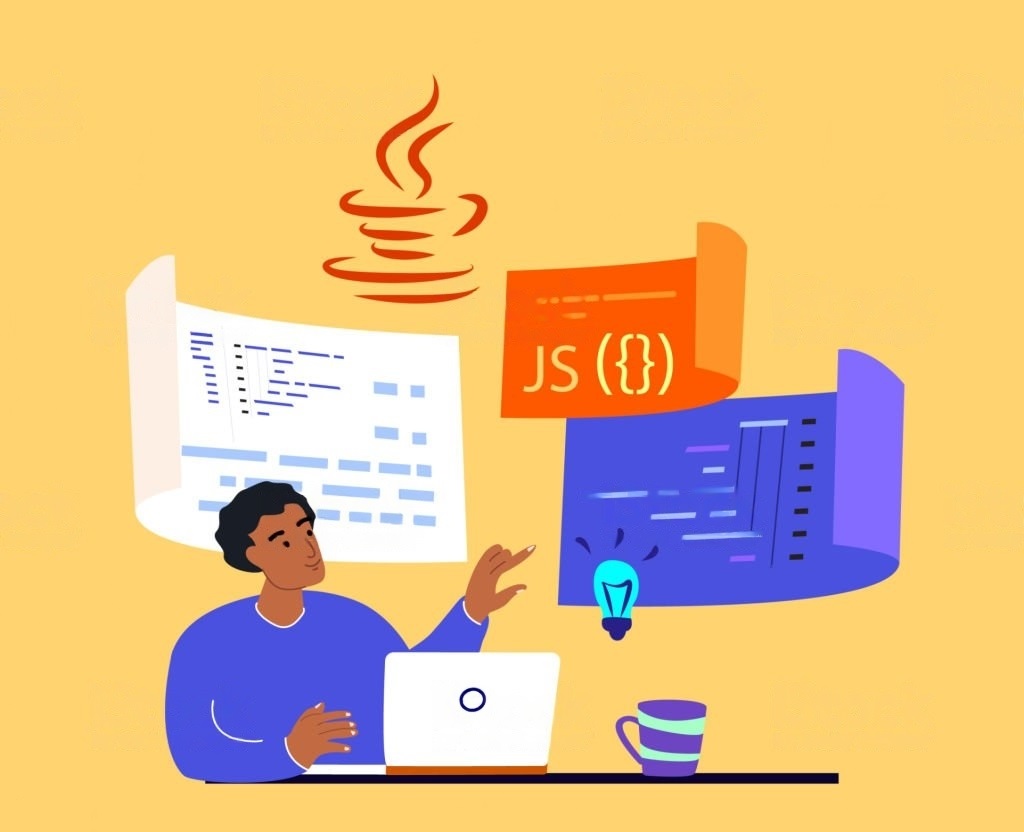Hey there, fellow web enthusiasts! 🌐
Did you know that JavaScript, the super popular programming language we all love, has been around for more than 25 years? That’s right! Time flies when you’re having fun coding, doesn’t it? 😄
You might be curious to know how JavaScript has managed to stay relevant and maintain its position as the go-to language for web development.
Well, you’re in luck! Today, we’ll be diving into the fascinating history and evolution of JavaScript, from its humble beginnings to the powerful language it is today.
So, fasten your seatbelts, and let’s embark on this exciting journey through time! 🚀
Let’s start with a quick throwback to the early days of the World Wide Web. Imagine the year is 1995, and the internet is just beginning to take off.
Back then, websites were mostly static, with HTML and CSS handling the structure and styling. But something was missing—a way to create dynamic and interactive content for users. 💡
Enter JavaScript! 🎉
JavaScript was created by Brendan Eich in just 10 days at Netscape Communications.
Originally named Mocha, it was quickly rebranded to LiveScript and finally to JavaScript, a name that aimed to capitalize on the popularity of the Java programming language at the time (although the two languages are not directly related). 🤓
JavaScript has undergone massive changes, with new features, improvements, and even entire frameworks and libraries emerging. Did you know that today, 97.6% of all websites use JavaScript in some way?
Talk about a global impact! 🌍
Enough with the teasers, though!
Are you ready to uncover the fascinating milestones in JavaScript’s journey and explore how it evolved into the powerhouse it is today? Let’s get started! 😎👩💻👨💻
Table of Contents
- Evolution of JavaScript: Major Milestones
- JavaScript Frameworks and Libraries
- The Future of JavaScript
- Summary
Evolution of JavaScript: Major Milestones
ECMAScript 3 (1999) 📜
In 1999, ECMAScript 3 came along with some cool new features and improvements, like error handling with try and catch, and the introduction of the in operator.
These enhancements made JavaScript more versatile and user-friendly. Remember, this was when websites were mostly static, so this update was a pretty big deal! 😮
AJAX (2005) 🌐
Fast forward to 2005, when AJAX (Asynchronous JavaScript and XML) took the stage. This technology allowed web pages to update content without refreshing the entire page.
It was a game-changer, making websites feel more responsive and interactive.
Think of how Gmail works: when you send an email, only the relevant part of the page updates, not the entire page! This is AJAX in action. 💌
ECMAScript 5 (2009) 🛠️
2009 was a pivotal year for JavaScript, with the release of ECMAScript 5.
This update brought significant language enhancements, like strict mode, Object.create(), and Array.prototype methods. These features allowed developers to write cleaner, more maintainable code.
ES5 is still widely used today, with 93% of all websites using some form of it. 🌟
Node.js (2009) 🖥️
That same year, Node.js was introduced, extending JavaScript’s capabilities to the server-side. Before Node.js, JavaScript was primarily used for client-side scripting.
Now, developers could build entire web applications using just JavaScript! Node.js became immensely popular, with big names like Netflix, LinkedIn, and Walmart using it in their tech stacks. 🚀
ECMAScript 6 (ES6) (2015) 🎉
In 2015, JavaScript got its most significant update yet with ECMAScript 6 (ES6).
This update introduced a plethora of new features, like arrow functions, template literals, and classes. It made JavaScript more powerful and easier to work with, leading to a surge in its popularity.
Today, around 82% of developers use ES6 features in their projects. 💪
Ongoing Updates 🔄
Since ES6, ECMAScript updates have followed an annual release cycle, with new features and improvements added each year.
This ensures that JavaScript stays up-to-date and continues to meet the ever-evolving needs of the web development community.
So, you can expect JavaScript to keep growing and becoming even more awesome! 😎
JavaScript Frameworks and Libraries
jQuery (2006) 🎈
Back in 2006, jQuery was introduced to simplify DOM manipulation and AJAX. Before jQuery, working with the DOM was a bit of a hassle. jQuery made it super easy to select elements, handle events, and perform animations.
It was a massive hit, with around 84% of the top 1 million websites using it at its peak! Even today, jQuery is still used on about 73% of all websites. 😮
Backbone.js (2010) 🦴
In 2010, Backbone.js emerged, introducing the concept of MV* (Model-View-*) architecture in JavaScript applications. This design pattern helped organize and structure code, making it easier to maintain and scale.
Backbone.js was one of the first JS libraries to bring structure to the wild west of web development. Some popular websites like SoundCloud and Trello still use Backbone.js today! 🎶
AngularJS and Angular (2010, 2016) 🅰️
AngularJS burst onto the scene in 2010, revolutionizing web application development. Developed by Google, it introduced two-way data binding, dependency injection, and a modular architecture.
AngularJS was a hit, and in 2016, its complete rewrite, Angular (without the “JS”), was released.
Angular is now a popular choice for building large-scale web applications, with companies like Microsoft, Adobe, and IBM using it in their projects. 🚀
Vue.js (2014) 💚
Vue.js entered the scene in 2014 as a lightweight and versatile alternative to other frameworks.
Developed by ex-Google engineer Evan You, Vue.js combines the best features of Angular, React, and Backbone.js.
It’s easy to learn, has a gentle learning curve, and offers excellent performance. Vue.js has gained a loyal following, and companies like Alibaba, Xiaomi, and Adobe use it in their projects. 🛠️
The Future of JavaScript
Upcoming ECMAScript features and improvements 🌟
The future of JavaScript looks bright, with many new ECMAScript features and improvements on the horizon.
The TC39 committee, responsible for maintaining and evolving the language, is continuously working to enhance JavaScript. Each year, new updates are released, ensuring that JavaScript remains modern and relevant.
So, stay tuned for even more fantastic features to level up your web development game! 🚀
WebAssembly and its implications on JavaScript 🕸️
WebAssembly is an emerging technology that’s set to revolutionize web performance. It’s a low-level binary format that runs at near-native speed in modern web browsers. But don’t worry, JavaScript isn’t going anywhere! 🙌
WebAssembly is designed to complement JavaScript, not replace it. The two technologies will work together to create even more performant and efficient web applications. Exciting times ahead! 🎉
The ongoing development of JavaScript frameworks and libraries 📚
The world of JavaScript frameworks and libraries is ever-evolving. Developers are continually pushing the boundaries of what’s possible with JavaScript, and new tools are being created to solve emerging problems.
As a result, we can expect ongoing development and innovation in this space.
So, keep an eye out for the next big thing in JavaScript, whether it’s a new framework, library, or design pattern that takes the web development world by storm! ⚡
Summary
JavaScript has come a long way since its inception over 25 years ago. From its humble beginnings as a simple scripting language to the powerful and versatile tool it is today, JavaScript has truly transformed the landscape of web development. 🌐
Through its evolution, we’ve seen the introduction of major updates like ECMAScript 6 and the birth of game-changing frameworks and libraries like React, Angular, and Vue.js.
And with exciting advancements like WebAssembly and ongoing innovation in the JavaScript ecosystem, the future of web development looks brighter than ever. 😄
As we embrace the future, it’s essential to stay curious, keep learning, and adapt to the ever-changing world of JavaScript. As developers, we have the power to shape the future of the web, one line of code at a time.
So, let’s continue to explore, innovate, and create amazing web experiences for users all around the globe! 🌍🚀👩💻👨💻
Happy coding, and may the JavaScript force be with you! 😉💻✨
Thank you for reading our blog, we hope you found the information provided helpful and informative. We invite you to follow and share this blog with your colleagues and friends if you found it useful.
Share your thoughts and ideas in the comments below. To get in touch with us, please send an email to dataspaceconsulting@gmail.com or contactus@dataspacein.com.
You can also visit our website – DataspaceAI


